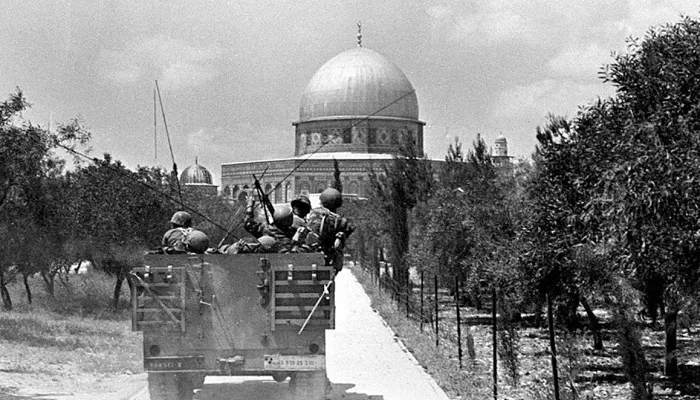
Many underlying concerns in the Arab-Israeli conflict contributed to the escalation that led to the Six-Day War:
Territorial conflicts played a significant role in precipitating the conflict. After Israel was founded in 1948, the future of the West Bank, the Gaza Strip, and East Jerusalem became unclear. The status of these areas, which had previously been ruled by Jordan and Egypt, was a point of disagreement.
Israel saw its neighbors as a growing threat. President Gamal Abdel Nasser of Egypt headed an Arab coalition that declared war on Israel. Tensions escalated after Nasser nationalized the Suez Canal in 1956 and blocked Israeli trade through the Straits of Tiran in 1967.
The Israelis were worried that Egypt and Syria were planning a military invasion against Israel. Israeli anxiety about a possible preemptive strike was exacerbated by Egypt's deployment of troops to the Sinai Peninsula and its military cooperation with Jordan and Syria.
In the years preceding up to the conflict, tensions between Israel and its neighbors were already high due to water disputes over the Jordan River and border clashes.

Significant Occurrences during the Six Day War:
Significant military activities occurred in just six days, from June 5 to June 10, 1967, as the war quickly developed.
Preemptive Strikes:
On June 5, 1967, Israel conducted a preemptive strike against Egyptian airfields in an effort to weaken the Egyptian Air Force. Operation Focus, the initial onslaught, was a huge success and took the Arab powers off guard.
Air Superiority:
The Israeli Air Force was able to maintain air superiority and provide crucial air support for ground forces thanks to their early victories in the air fight.
Ground Operations:
Israeli ground forces pushed swiftly into the Sinai Peninsula, seizing Egyptian land. Jerusalem was reunited at the same time as Israeli forces went on the offensive in the West Bank and East Jerusalem.
Jordanian Involvement:
Jordan began the conflict by launching mortar attacks on West Jerusalem and other Israeli cities. In retaliation, Israeli troops conquered the West Bank and the holy city of Jerusalem's Old City. Israel took possession of holy sites like the Dome of the Rock and the Western Wall.
Syrian Front:
On the Golan Heights, Israel fought alongside Syrian forces as well. After a tough battle, Israeli forces were able to take control of the strategically vital Golan Heights.
Ceasefire:
On June 10, 1967, the Six-Day War ended, and Israel gained control of the Sinai Peninsula, the Gaza Strip, the West Bank, East Jerusalem, and the Golan Heights. After a plea for peace from the United Nations, both sides were able to put an end to the fighting.

Impact of the Six-Day War:
The Six-Day War had far-reaching and long-lasting consequences for the region:
Territorial Changes:
As a result of their triumph, Israel gained considerable territory. It conquered the Golan Heights from Syria, the West Bank and East Jerusalem from Jordan, and the Sinai Peninsula and Gaza Strip from Egypt. The geography of the Middle East has been drastically altered as a result of these purchases.
Jerusalem Reunification:
The reunification of Jerusalem was a major symbolic victory for the winning side. Israel officially designated the city as its capital, but at first, the city wasn't recognized as such by the world community. Jerusalem's legal classification is still up for debate.
Palestinian Question:
The fighting has made the situation for Palestinian refugees even worse. Many hundreds of thousands of Palestinians now reside in refugee camps after being forced from their homes. The Israeli-Palestinian conflict has been going on since the Israeli occupation of the West Bank and the Gaza Strip.
Regional Dynamics:
The outcome of the Six-Day War changed the dynamic of power in the region. Israel's military triumphed, making it the region's top power, while Arab nations suffered crushing political and military defeats. Alliances and rivalries in the region shifted as a result of this change.
Ongoing Conflict:
No meaningful peace agreement was reached as a result of the war. Instead, it set the stage for ongoing tensions and talks. Resolution 242 was enacted by the United Nations demanding Israeli departure from occupied territory in exchange for peace.
Arab Unity and Radicalization:
The Six-Day War defeat of the Arab states diminished the power of established Arab leaders. More extremist and violent parties, such as the Palestine Liberation Organization (PLO), rose to prominence as pan-Arab nationalism declined.
Geopolitical Consequences:
The war affected relations between the superpowers during the Cold War, which was felt all around the world. In contrast to the Soviet Union's support for Arab nations, the United States has emerged as a crucial supporter for Israel. This affected the regional geopolitical equilibrium.
Peace Process:
The Israeli-Arab conflict is still being molded by the repercussions of the war. Negotiations, peace agreements, and conflicts marked the decades that followed in an effort to build a sustainable peace.
To sum up, the Six-Day War of 1967 was a turning point in the history of the Middle East. It fundamentally altered the region's geopolitical environment and laid the foundation for further battles and subsequent peace discussions. Key legacies of this short but profound warfare include new territorial boundaries, the reunification of Jerusalem, and the ongoing Israeli-Palestinian conflict.







